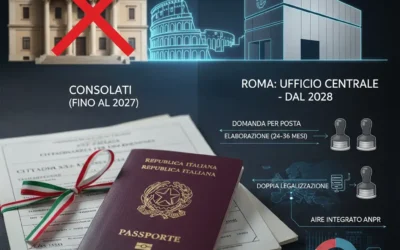Italy opens its doors to foreign workers: nearly 165,000 entries expected each year
The Italian government has published the new three-year immigration plan (2026-2028) in the Official Gazette on 15 October 2025. This document sets out how many foreign workers can legally enter the country and in which sectors they can work.
For a quick read of this article read Italy’s Flussi Decree 2026–2028: 500,000 Work Visa Quotas Announced
What is the Immigration Flows Decree– Decreto Flussi?
Every three years, the Italian government issues this important document that regulates migration policies based on actual labour market requirements. The decree specifies how many positions are available for different worker categories: seasonal employees, permanent staff, and self-employed professionals.
How are the numbers of the flussi decree decided?
The government considers several key factors when setting immigration quotas:
- Labour market analysis: actual workforce needs identified by the Ministry of Labour
- Gradual increase: numbers grow progressively over the three years
- Integration capacity: local communities’ ability to welcome new workers
- Sector diversity: expanding opportunities across various industries
- Training programmes: supporting education initiatives in countries of origin
- International cooperation: partnering with origin and transit countries to prevent illegal immigration
- Skilled professionals: prioritising highly qualified workers
- Humanitarian support: assisting refugees and stateless persons
The decree also gives preference to citizens from countries that actively campaign against illegal migration dangers and maintains special allocations for caregivers and descendants of Italian citizens living in Venezuela
When can you apply- Decreto Flussi?
- Agricultural seasonal workers: from 12 January
- Tourism seasonal workers: from 9 February
- Permanent employees: from 16 February
- Domestic workers and caregivers: from 18 February
Total entries allowed
Here’s the breakdown of total foreign workers permitted entry over the three years:
- 2028: 166,850 people
- 2026: 164,850 people
- 2027: 165,850 people
Permanent employment opportunities: 76,200 positions yearly
The decree significantly expands the sectors where foreign workers can find permanent employment. Each year, 76,200 positions are available across these industries:
- Farming and agriculture
- Forestry and fishing
- Food production, beverages, and tobacco
- Textiles, clothing, and footwear manufacturing
- Building and construction
- Wholesale and retail businesses
- Hotels and restaurants
- Tourism industry
- Transportation, logistics, and storage
- Business and personal support services
- Healthcare, social services, and private medical care
- Self-employment opportunities (650 positions annually)
Special allocations within the 76,200 positions
The government has set aside specific quotas for particular groups:
Priority countries (25,000 spots yearly)
Workers from these 38 countries get preferential treatment: Albania, Algeria, Bangladesh, Bosnia-Herzegovina, South Korea, Ivory Coast, Ecuador, Egypt, El Salvador, Ethiopia, Philippines, Gambia, Georgia, Ghana, Japan, Jordan, Guatemala, India, Kyrgyzstan, Kosovo, Mali, Morocco, Mauritius, Moldova, Montenegro, Niger, Nigeria, Pakistan, Peru, North Macedonia, Senegal, Serbia, Sri Lanka, Sudan, Thailand, Tunisia, Ukraine, and Uzbekistan.
Countries with cooperation agreements
Nations that sign migration cooperation deals with Italy receive growing allocations:
- 2026: 18,000 positions
- 2027: 26,000 positions
- 2028: 34,000 positions
Venezuelan descendants of Italians
Small quotas exist for self-employed individuals of Italian ancestry (up to third-degree relatives) residing in Venezuela and other designated countries.
Refugees and stateless persons: 320 positions yearly
The decree reserves 320 spots annually for vulnerable individuals recognized by UNHCR or relevant authorities (300 for employees, 20 for self-employed).
Caregivers and domestic workers: substantial increase
The allocation for home care assistants has grown significantly compared to the previous three-year period (which had only 9,500 total positions):
- 2026: 13,600 positions
- 2027: 14,000 positions
- 2028: 14,200 positions
Self-employed professionals and entrepreneurs: 500 yearly
Each year, 500 foreign nationals can enter Italy for self-employment (1,500 total over three years) under these categories:
- Business investors: Must invest at least €500,000 in the Italian economy and create minimum 3 jobs
- Licensed professionals: Regulated professions with nationally recognized qualifications
- Corporate officers: Board members and controllers as specified in regulations
- Renowned artists: Highly qualified performers hired by public or private organizations
- Startup founders: Individuals establishing innovative startups (as defined by Law 221/2012) with self-employed status
Seasonal workers: 88,000+ positions
Seasonal employment in agriculture and tourism sectors offers the following opportunities:
- 2026: 88,000 positions
- 2027: 89,000 positions
- 2028: 90,000 positions
Special allocation for cooperation countries
- 2026: 12,600 positions
- 2027: 12,750 positions
- 2028: 13,000 positions
Additional seasonal worker benefits
Returning workers
Those who entered Italy at least once in the past 5 years and whose employers request multi-year permits get reserved spots:
- 2026: 5,000 positions
- 2027: 6,000 positions
- 2028: 7,000 positions
Agricultural sector priority (47,000 yearly)
Major farming organizations (including National Direct Farmers Confederation, Italian Farmers Confederation, and others) can sponsor workers from priority countries. These organizations oversee the entire hiring process until contract signing.
Tourism sector priority
Leading tourism industry associations can sponsor workers through dedicated channels:
- 2026: 13,000 positions
- 2027: 14,000 positions
- 2028: 15,000 positions
Application deadlines (“Click Day” Decreto Flussi)
Mark your calendars! Applications open at 9:00 AM on these dates each year:
- 12 January: Agricultural seasonal workers
- 9 February: Tourism seasonal workers
- 16 February: Permanent employees and self-employed workers (priority countries and cooperation agreements)
- 18 February: Domestic workers and caregivers
Important note: Official guidelines will specify exact application procedures and required documentation, including proof that employers searched for available workers within Italy before hiring foreign nationals.





